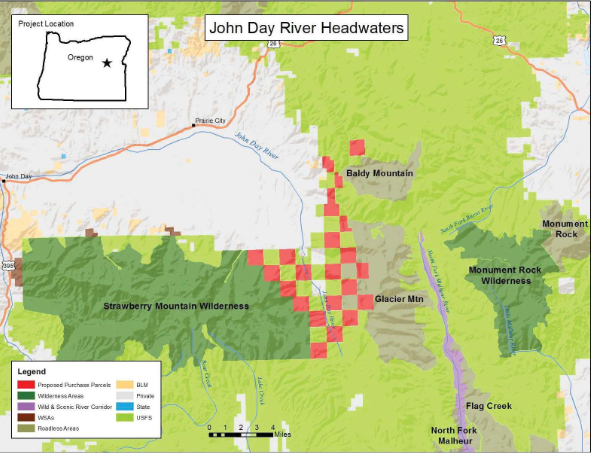
The Rocky Mountain Elk Foundation’s (RMEF) work doesn’t always conjure up a vision of aquatic preservation, but the John Day Headwaters Project has changed that.
In December 2013, after years of dedication and hard work, RMEF acquired 13,082 key acres of private lands in the headwaters of the John Day River (shown in red, above), an area rich in aquatic and biological diversity. The acquisition turned a checkerboard of Malheur National Forest and private land into one contiguous piece now owned and managed by the U.S. Forest Service for permanent protection.
Critical habitat for the largest and most diverse native fish populations in Oregon are protected from development with this acquisition. Bull trout, redband trout, westslope cutthroat trout, Chinook salmon, steelhead, and Pacific lamprey all benefit from this RMEF project.
Bill Richardson, RMEF Oregon Lands Program Manager, couldn’t be happier with the project.
“It’s unique for RMEF to have aquatics be the featured ‘other wildlife’ part of this project. It’s an unbelievable accomplishment that so many people shared, and I think all of us are pinching ourselves that we were able to pull it off,” Richardson said.
RMEF’s mission is “to ensure the future for elk, other wildlife, their habitat, and our hunting heritage”.
The John Day Headwaters Project accomplished all that and more. It is a perfect example of hunters working with the conservation community to not only protect big game and their habitats, but also at least 20 state and federal special status species.
The project creates a landscape of more than 40 miles of public land by knitting together the nearby Strawberry and Mountain Rock Wilderness Areas to the adjacent Glacier Mountain and Baldy Mountain Roadless Areas.
Elk, deer, pronghorn antelope, mountain goat, black bear, and wolverine (listed as threatened in Oregon) move between the summer and winter ranges. Locally unique whitebark pine and Pacific yew trees thrive here.
Western Tanager, Mountain and Western Bluebird, Black-headed Grosbeak, Hermit Thrush, Ruby-crowned Kinglet, McGillivray’s Warbler, and many others are found in the project area. The U.S. Forest Service’s riparian restoration will improve habitat and increase the diversity and abundance of these birds that depend on healthy riparian habitat. Simultaneously, restoration will meet objectives in the Oregon Conservation Strategy, Oregon Joint Venture Eastern Oregon Plan, and the national Partners in Flight program.
The John Day Headwaters Project was a successful collaboration between RMEF, the D.R. Johnson Family, and the U.S. Forest Service. The National Fish and Wildlife Foundation’s Acres for America program and local, state, and private partners also joined to help preserve the critical habitats, fish, and wildlife in this unique area.
This type of partnership is the essence of the Oregon Conservation Strategy. This land, located within a Conservation Opportunity Area, was once susceptible to development. However, it is now a preserved landscape that will benefit Oregon’s fish, wildlife, and their habitats in perpetuity.